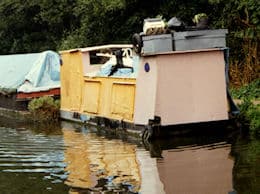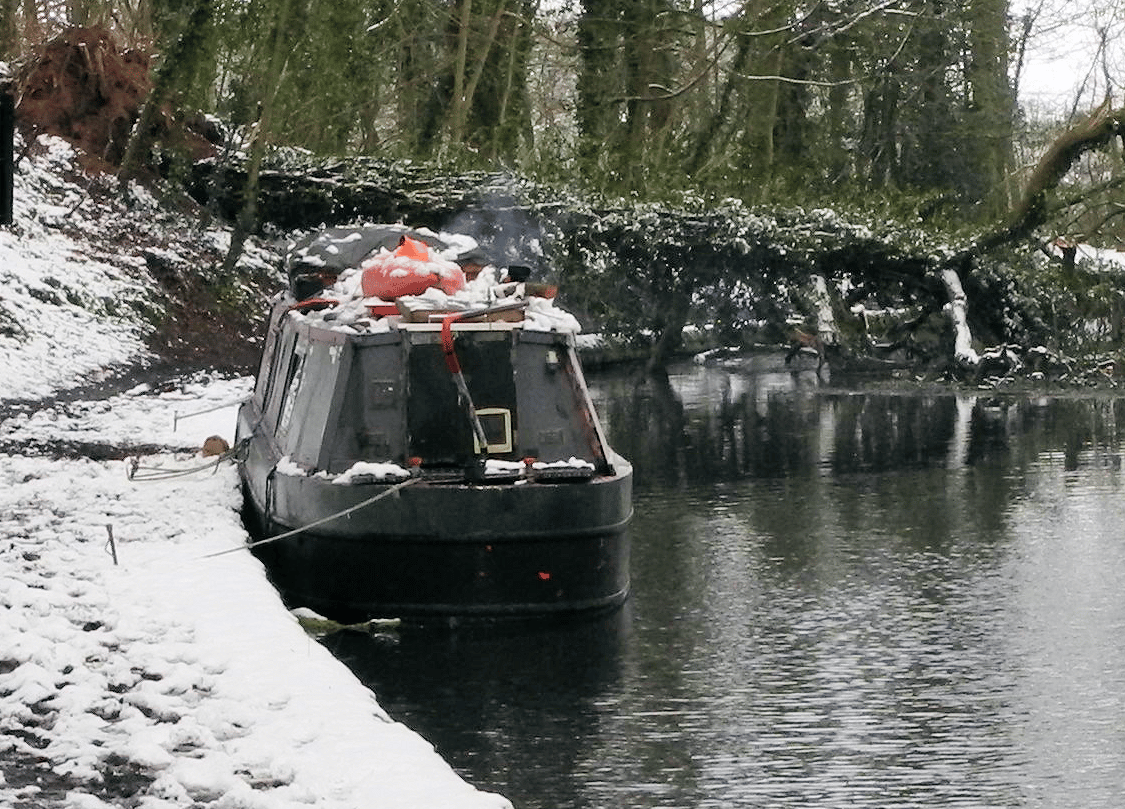Living on a boat on a canal or river mooring.
You can live on a boat on a canal or river like thousands of other ‘liveaboards’. However you must keep moving or be on a ‘residential mooring’.
Trying to stay in one area without an official residential mooring can be a very insecure way of life. You can be told to move regularly. If you don’t move far enough or frequently enough you could be refused a licence, fined and eventually have your boat seized.
So can I live on a mooring on a canal boat?
Yes, if you keep to the mooring rules.
- Short Term mooring is allowed along most canal towpaths (though not on the opposite bank or near locks or bridges). But no boat can moor there for more than two weeks, a few days in some indicated places.
- Long term moorings are where most boaters pay to keep their boats. They may be on a marina or ‘online’ alongside the canal. The boat can be moored long term but they usually don’t allow you to live on your boat for more than a few days or weeks.
- A Residential Mooring is needed if you want to live aboard your boat anywhere on the canals for more than a few days whilst staying in one place or area.
- Continuous Cruising is where you live on your boat while keeping moving. But mooring regulations do not allow you ‘shuffle’ between nearby short term moorings.
- So to live on a boat you need to be either ‘continuously cruising’ or to have a ‘residential mooring’. Complicated we know, so please keep on reading!.
Why can’t I moor anywhere I want for as long as I want?
Because other canal users have to be considered.
Canal and River Trust (CRT) have the job of managing our canals and some rivers. For many years living on a boat had been seen, rightly or wrongly, as a way of avoiding paying rent and rates or of getting to the top of the council house waiting lists. The freedom of living afloat with low overheads was thought to appeal to many people who wanted to ‘turn their backs on consumer society’. Equally though, some of the most desirable London properties float on the Thames or Regents Canal, and many people retired, sold the house and moved onto a canal boat to explore their own country.
Recently, possibly partly because of a shortage of economic accommodation, large increases in liveaboard boats have been reported, especially in a few locations. CRT reported that the total number of Continuous Cruising licences increased from 4,400 in 2012 to 5,400 in 2014, with an 85% increase in over one year in East London alone. Out of those 5,400 boats 16% moved less than 5 kilometres, and 66% moved under 20 kilometres in a year.
This all puts pressure on the system. Leisure boaters complain that they can’t find convenient moorings because short term visitor moorings are full of long stay liveaboards. Canal users and local people complain about unsightly boats moored in long lines. Local Authorities may be unhappy about the extra pressure on local services. CRT has been working with local groups including boat dwellers in some of the worst affected areas, like London and the western Kennet and Avon to try to find solutions to these problems, see more in our Canal News Section.
CRT also have to get as much income from canal users as possible. Boat owners have to pay for a licence and moorings can cost over £2,000 a year. They want all canal users to contribute to the costs of running the canals.
So how do I find a place to liveaboard my boat?
Unfortunately residential moorings are in short supply.
Residential moorings where you can live on a boat long term certainly exist. The Canal & River Trust and The Environment Agency run some, there are privately owned residential moorings on some boatyards and marinas. But there aren’t enough residential moorings in the places like the major cities where many people need to live. And of course mooring and residence fees have to be paid.
It is often easier to buy a boat with a residential mooring, rather than get them separately. Getting a boat is no problem (see Buying a residential boat), finding a mooring is, and boats with a mooring often change hands for more than twice the boat value.
If you know the area where you would like to moor then walk the towpath and talk to people on boats to see what they know. Visit boatyards (see our listings) and ask if they know of any residential moorings. Contact the Canal and River Trust to see if they have any residential moorings locally, they are trying to set up more residential places
In cities such as London most floating accommodation gets advertised and let through the normal property sales and letting channels, estate agents etc.
Can I keep on moving, become a Continuous Cruiser?
Yes, so long as you are genuinely going somewhere, not shuffling about!
Many people living on their boats move around the canal system regularly and they are known as ‘Continuous Cruisers‘. They are on ‘extended cruises’. They don’t pay for a ‘home mooring’ on a marina or canalside and can use short term moorings around the canals.
This is fully acceptable under the licensing regulations, however there are important restrictions. The Canal and River Trust explains to boaters who don’t have a home mooring ‘.. you don’t have a home mooring for your boat, so you’re registered as a ‘continuous cruiser’. This means that throughout the period of your licence you must ‘bona fide’ navigate and not stay in the same place for more than 14 days. The definition of navigating implies a journey of some length, so you can’t shuffle to and fro in a small area, just because that’s where your work or other commitments are.‘This definition of continuous cruising meaning ‘real movement’ has been upheld in the courts. Make sure you read the CRT ‘Guidance for Boaters without a Home Mooring‘ and see our relevant News Reports such as What it means to be a Continuous Cruiser.
How far must I move and how often? And what if I don’t?
Hard to say, but it could make living in a single area impossible.
A stay of 2 weeks is the maximum on most short term moorings, sometimes it is just 48 hours. Boaters must then continue their journey. This shouldn’t create problems if you are genuinely cruising the system, but by restricting mooring duration in one place, minimum distance to the next temporary moorings and restrictions on return, it will make your life difficult if you live on a boat and want to stay in the same geographical area, for work perhaps.
Although CRT express sympathy for those who can’t find residential moorings in the area in which they work or wish to live, they state ‘ Our duties do not include those of a housing authority‘.
If you don’t comply CRT say they will be examining how far boats have moved over the course of their previous licence to see if they satisfy the requirement for continuous cruising. Regular reminders will be sent to all those boaters whose limited movement is causing a concern.
On the expiry of their licence, those that have consistently failed to move in accordance with the Trust’s Guidance will be refused a new licence unless they take a home mooring. See their Enforcement Information.
What about in the winter?
Special CRT November to March Winter Mooring Permits are available.
Continuous cruisers can find moving difficult in winter because of bad weather and canal maintenance closures. CRT now offer some temporary residential moorings available over the winter so continuous cruisers can stay in one place through the winter, then cruise from spring to autumn.
See the CRT website for more details.
All materials and images © Canal Junction Ltd. Dalton House, 35 Chester St, Wrexham LL13 8AH. No unauthorised reproduction.
About
| Terms
| Privacy |
Returns |
Sitemap
| Contact Us
Web Hosting & Development
With over 800 pages, this website uses cookies to record visitor behaviour using Google Analytics. More information on Privacy Page. Page last updated: 13/10/2025.









Back to Menu....
Boat Owners >>
Living on a Canal Boat >>